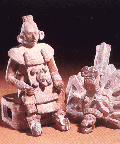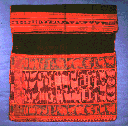

 The humid tropical climate of Central America has destroyed most of the
evidence of the past, except for the great stone pyramids, sculptures, and
other structures, many of which were lost for centuries in the jungles.
Ceramics have also survived. The images of people seen in sculpture and
ceramics show elaborate costume, and suggest textile and dress forms that are
similar to those worn by Mayan people today. Textiles remain an important
aspect of Mayan culture. The designs woven into the cloth, and the forms of
dress differ from village to village in Guatemala. Recently there has been a
revival of the wearing of traditional dress as a sign of pride and solidarity,
and a protest against the oppression experienced by Mayan people.
The humid tropical climate of Central America has destroyed most of the
evidence of the past, except for the great stone pyramids, sculptures, and
other structures, many of which were lost for centuries in the jungles.
Ceramics have also survived. The images of people seen in sculpture and
ceramics show elaborate costume, and suggest textile and dress forms that are
similar to those worn by Mayan people today. Textiles remain an important
aspect of Mayan culture. The designs woven into the cloth, and the forms of
dress differ from village to village in Guatemala. Recently there has been a
revival of the wearing of traditional dress as a sign of pride and solidarity,
and a protest against the oppression experienced by Mayan people.
 Textiles were also of great importance in Andean civilizations. They were a
form of wealth, and designated status. Ceremonial uses of cloth gave it
spiritual significance as well. The making of cloth was a state concern, and
the best weavers from among the young girls of the land were brought to the
capital to weave in royal workshops. Early examples of textiles were found at
burial sites on the western coastal deserts. These burials involved the
dressing and wrapping of the body in elaborate textiles. The woven textiles of
the Andes are among the most complex weavings in the world, and yet the loom
used is among the simplest.
Textiles were also of great importance in Andean civilizations. They were a
form of wealth, and designated status. Ceremonial uses of cloth gave it
spiritual significance as well. The making of cloth was a state concern, and
the best weavers from among the young girls of the land were brought to the
capital to weave in royal workshops. Early examples of textiles were found at
burial sites on the western coastal deserts. These burials involved the
dressing and wrapping of the body in elaborate textiles. The woven textiles of
the Andes are among the most complex weavings in the world, and yet the loom
used is among the simplest.
 Today the Quechua and Aymara peoples of the Andes continue to weave. Although
many are forsaking old ways, the traditions survive in some regions. Cloth
remains at the center of the spiritual life of the community; special bundles
of cloth are kept and revered as embodiments of their ancestors. Some of these
cloths may be centuries old. On certain occasions the cloths are taken out from
their storage, and displayed during festivals, or carried around the bounds of
the village lands, as if taking the ancestors for an outing. The details of
pattern, color, structure, and even the twist of the thread carries symbolic
meaning that identifies the locality, the function, the gender and status of
the user.
Today the Quechua and Aymara peoples of the Andes continue to weave. Although
many are forsaking old ways, the traditions survive in some regions. Cloth
remains at the center of the spiritual life of the community; special bundles
of cloth are kept and revered as embodiments of their ancestors. Some of these
cloths may be centuries old. On certain occasions the cloths are taken out from
their storage, and displayed during festivals, or carried around the bounds of
the village lands, as if taking the ancestors for an outing. The details of
pattern, color, structure, and even the twist of the thread carries symbolic
meaning that identifies the locality, the function, the gender and status of
the user.
 In recent years, Andean cloth, both pre-Columbian and more recent, has been the
object of collectors. As the supply of old textiles in the markets has been
depleted, sacred cloth bundles have been sold or stolen from their home
villages, to the consternation of community members, for whom these are
embodiments of ancestors. At the same time, foreign interest in these textiles
has also engendered a renewed interest in weaving. This has occasionally led to
the reintroduction of weaving in places where the traditions had been
abandoned.
In recent years, Andean cloth, both pre-Columbian and more recent, has been the
object of collectors. As the supply of old textiles in the markets has been
depleted, sacred cloth bundles have been sold or stolen from their home
villages, to the consternation of community members, for whom these are
embodiments of ancestors. At the same time, foreign interest in these textiles
has also engendered a renewed interest in weaving. This has occasionally led to
the reintroduction of weaving in places where the traditions had been
abandoned.

| 
| 
| 
|